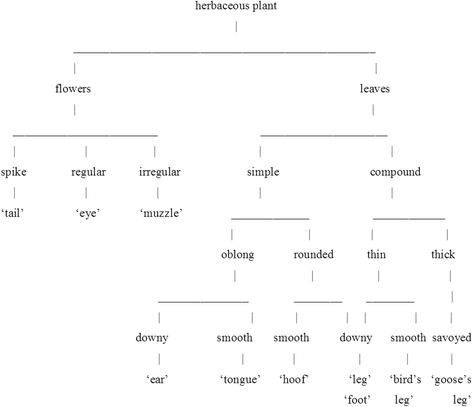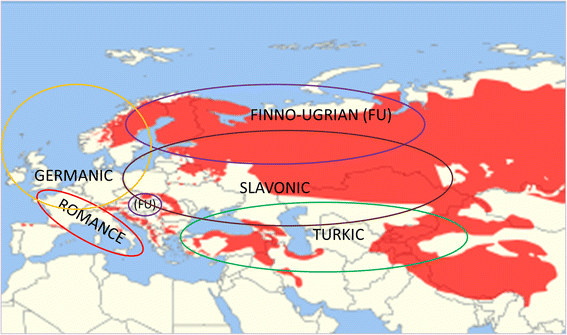The bear in Eurasian plant names: motivations and models
- PMID: 28222790
- PMCID: PMC5320662
- DOI: 10.1186/s13002-016-0132-9
The bear in Eurasian plant names: motivations and models
Abstract
Ethnolinguistic studies are important for understanding an ethnic group's ideas on the world, expressed in its language. Comparing corresponding aspects of such knowledge might help clarify problems of origin for certain concepts and words, e.g. whether they form common heritage, have an independent origin, are borrowings, or calques. The current study was conducted on the material in Slavonic, Baltic, Germanic, Romance, Finno-Ugrian, Turkic and Albanian languages. The bear was chosen as being a large, dangerous animal, important in traditional culture, whose name is widely reflected in folk plant names. The phytonyms for comparison were mostly obtained from dictionaries and other publications, and supplemented with data from databases, the co-authors' field data, and archival sources (dialect and folklore materials). More than 1200 phytonym use records (combinations of a local name and a meaning) for 364 plant and fungal taxa were recorded to help find out the reasoning behind bear-nomination in various languages, as well as differences and similarities between the patterns among them. Among the most common taxa with bear-related phytonyms were Arctostaphylos uva-ursi (L.) Spreng., Heracleum sphondylium L., Acanthus mollis L., and Allium ursinum L., with Latin loan translation contributing a high proportion of the phytonyms. Some plants have many and various bear-related phytonyms, while others have only one or two bear names. Features like form and/or surface generated the richest pool of names, while such features as colour seemed to provoke rather few associations with bears. The unevenness of bear phytonyms in the chosen languages was not related to the size of the language nor the present occurence of the Brown Bear in the region. However, this may, at least to certain extent, be related to the amount of the historical ethnolinguistic research done on the selected languages.
Keywords: Brown bear Ursus arctos; Ethnobotany; Ethnolinguistics; Latin calques; Motivation; Phytonyms; Traditional knowledge.
Figures




Similar articles
-
[Old English plant names from the linguistic and lexicographic viewpoint].Sudhoffs Arch. 2004;88(2):175-209. Sudhoffs Arch. 2004. PMID: 15730144 German.
-
From the name to the popular image of the plant: the Polish names for the black elder (Sambucus nigra).J Ethnobiol Ethnomed. 2024 Jan 30;20(1):12. doi: 10.1186/s13002-024-00649-0. J Ethnobiol Ethnomed. 2024. PMID: 38291469 Free PMC article.
-
Molecular phylogeography of the brown bear (Ursus arctos) in Northeastern Asia based on analyses of complete mitochondrial DNA sequences.Mol Biol Evol. 2013 Jul;30(7):1644-52. doi: 10.1093/molbev/mst077. Epub 2013 Apr 25. Mol Biol Evol. 2013. PMID: 23619144
-
Sperm cryopreservation in brown bear (Ursus arctos): preliminary aspects.Reprod Domest Anim. 2008 Oct;43 Suppl 4:9-17. doi: 10.1111/j.1439-0531.2008.01248.x. Reprod Domest Anim. 2008. PMID: 18803752 Review.
-
The history of Latin teeth names.Acta Med Hist Adriat. 2015;13(2):365-84. Acta Med Hist Adriat. 2015. PMID: 27604204 Review.
Cited by
-
A study of the plant folk nomenclature of the Yi people in Xiaoliangshan, Yunnan Province, China, and the implications for protecting biodiversity.J Ethnobiol Ethnomed. 2022 Mar 15;18(1):18. doi: 10.1186/s13002-022-00504-0. J Ethnobiol Ethnomed. 2022. PMID: 35292043 Free PMC article.
-
Development of an Optimized Drying Process for the Recovery of Bioactive Compounds from the Autumn Fruits of Berberis vulgaris L. and Crataegus monogyna Jacq.Antioxidants (Basel). 2021 Oct 7;10(10):1579. doi: 10.3390/antiox10101579. Antioxidants (Basel). 2021. PMID: 34679714 Free PMC article.
References
-
- Thiselton-Dyer TF. The folk-lore of plants. London: Chatto & Windus; 1889.
-
- Kreiter H. Die von Tiernamen abgeleiteten Pflanzennamen im Französischen. Diss. Darmstadt: C. F. Winter; 1912.
-
- Marzell H. Die Tiere in deutschen Pflanzennamen: Ein botanischer Beitrag zum deutschen Sprachschatze. Heidelberg: C. Winter; 1913.
-
- Vajs N. Zoomorfski elementi u nazivima biljaka. Rasprave zavoda za jezik Instituta za filologiju i folkloristiku. 1979; IV-V:89–104.
-
- Dubrovina SJ. Russkaja botanicheskaja terminologija v etnolingvisticheskom osveshchenii (na materiale nazvanij rastenij, obrazovannyh ot nazvanij zhivotnyh i ptits). Kandidate dissertation. Moskva: 1991.
Publication types
MeSH terms
LinkOut - more resources
Full Text Sources
Other Literature Sources

